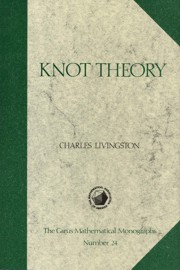Book contents
- Frontmatter
- ACKNOWLEDGEMENTS
- PREFACE
- Contents
- Chapter 1 A CENTURY OF KNOT THEORY
- Chapter 2 WHAT IS A KNOT?
- Chapter 3 COMBINATORIAL TECHNIQUES
- Chapter 4 GEOMETRIC TECHNIQUES
- Chapter 5 ALGEBRAIC TECHNIQUES
- Chapter 6 GEOMETRY, ALGEBRA, AND THE ALEXANDER POLYNOMIAL
- Chapter 7 NUMERICAL INVARIANTS
- Chapter 8 SYMMETRIES OF KNOTS
- Chapter 9 HIGH-DIMENSIONAL KNOT THEORY
- Chapter 10 NEW COMBINATORIAL TECHNIQUES
- Appendix 1 KNOT TABLE
- Appendix 2 ALEXANDER POLYNOMIALS
- REFERENCES
- INDEX
Chapter 6 - GEOMETRY, ALGEBRA, AND THE ALEXANDER POLYNOMIAL
- Frontmatter
- ACKNOWLEDGEMENTS
- PREFACE
- Contents
- Chapter 1 A CENTURY OF KNOT THEORY
- Chapter 2 WHAT IS A KNOT?
- Chapter 3 COMBINATORIAL TECHNIQUES
- Chapter 4 GEOMETRIC TECHNIQUES
- Chapter 5 ALGEBRAIC TECHNIQUES
- Chapter 6 GEOMETRY, ALGEBRA, AND THE ALEXANDER POLYNOMIAL
- Chapter 7 NUMERICAL INVARIANTS
- Chapter 8 SYMMETRIES OF KNOTS
- Chapter 9 HIGH-DIMENSIONAL KNOT THEORY
- Chapter 10 NEW COMBINATORIAL TECHNIQUES
- Appendix 1 KNOT TABLE
- Appendix 2 ALEXANDER POLYNOMIALS
- REFERENCES
- INDEX
Summary
The discovery of connections between the various techniques of knot theory is one of the recurring themes in this subject. These relationships can be surprising, and have led to many new insights and developments. A recent example of this occurred with the discovery by V. Jones of a new polynomial invariant of knots. Although his approach was algebraic, the Jones polynomial was soon reinterpreted combinatorially. Almost immediately there blossomed an array of new combinatorial knot invariants which appear to be among the most useful tools available for problems relating to the classification of knots. An understanding of these new invariants from a noncombinatorial perspective is now a major problem in the subject, and one that will certainly lead to significant progress. Chapter 10 is devoted to a discussion of the Jones polynomial and its generalizations.
To demonstrate how various techniques can be related, this chapter presents geometric and algebraic approaches to the Alexander polynomial. The geometric approach introduces a new and powerful object, the Seifert matrix, and for this reason geometry will be the main focus here. The algebraic approach links the combinatorics to the geometry, and also demonstrates that the Alexander polynomial of a knot is determined by the knot group.
It is not surprising that bringing together the diverse methods developed so far involves difficult technical arguments. Even the definition of the Seifert matrix, given in Section 1, is fairly complicated.
- Type
- Chapter
- Information
- Knot Theory , pp. 109 - 128Publisher: Mathematical Association of AmericaPrint publication year: 1993



